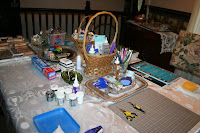
VSN is an intense event in which challenges are posted hourly. You have 45 minutes to complete each individual challenge and then fifteen minutes to neaten your work space, photograph and upload your card, and grab a quick snack. If you’ve made cards for any of SCS's daily challenges, you have some idea of what to expect. The difference is that the VSN challenges have a time restriction and they come one after another. While you don’t have to complete them immediately in the hour after they’re posted, a lot of the fun and excitement of participating in the VSN is to do just that – to work along with everyone else and get each card completed during that hour, before moving on to the next. Unlike daily challenges, with the VSN challenges you are restricted to a 45 minute time frame regardless of when you complete them.
If you do want to challenge yourself to complete each new project as they’re announced, then having an organized work space is key. If you can negotiate an area in your home that will be off-limits to everyone else for the duration of the VSN, you can set up work stations and spread out your craft supplies in a way that will let you work quickly and efficiently. This can make a world of difference with the timed challenges. Before I was blessed with a room in our home dedicated to my crafting, I would commandeer our living room/dining room area to set up a work area. This is one large room and I made use of every table and cabinet surface.
Setting up Your Work AreaAfter you decide where you are going to set your work space, the first step is to plan out how to lay out and arrange “work stations” for different tasks in a logical way. Bring out the things you use the most – you don’t need to bring out everything you have, just the things you are most likely to use, plus whatever is on the VSN shopping list. This is also a good time to go through and organize your stuff wherever you have it. You’ll rediscover things you might have forgotten you have and they’ll be fresh in your mind for the weekend.
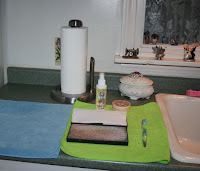
I am manic about cleaning my stamps and paint brushes immediately after I use them and so I set up a stamp cleaning area by the kitchen sink. I love micro fiber towels (you can get packs of 25 at Sam’s Club for a very affordable price). I use them for all kinds of cleaning chores and they are great for drying stamps and blocks. I do use a fair amount of paper towels as well so I make sure that there is a fresh roll on the spindle and extra rolls under the sink. When getting ready for VSN, I set out my stamp and brush cleaners, a stamp cleaning pad, and a soft toothbrush, which is another one of my favorite cleaning tools.
For the Mini Cabaret last fall, I set up a work area in our living room and dining room. I had my husband push the living room furniture to the side and set up a large folding banquet table that I used as a work table where I planned and designed the cards, gathered what I would need for a given card, and painted with watercolors or colored with my Prismacolors. I also set the Cuttlebug up there.
I used the dining room table to set up stations for cutting, stamping, embossing, and assembling the cards, and also set up a “bling bar” on the china cupboard. I’m one of those folks who loves china and fancy things, and how I set up my tables for the VSNs as well as my studio reflects that. When I set up for the Mini VSN, I dug out silver serving trays and baskets and a pretty crystal goblets and bowls. When I moved into my new studio, these things went with me. I think being surrounded by beautiful things enhances my creativity. Certainly, having things organized and neat allows me to stay within the time restrictions of the VSN.
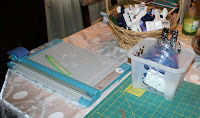
My cutting area has my rotary cutter, Cropodile, and CM cutting system, which are laid out on a quilt cutting mat. For cutting a single oval, the CM cutters are much quicker to use than the Cricut, and so despite numerous dies for the Cuttlebug and cartridges for the Cricut, they are still among my most favorite tools. Now, with my collection of Nesties and Cuttlebug folders, I’ll probably substitute those for the CM cutters when I get ready for this weekend’s “Crush”. Something new that I have to find a spot for is the Scor-Pal, which has become one of my top five favorite tools.
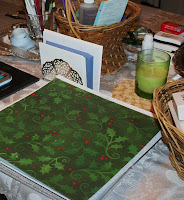
I set the rotary cutter on the corner so I can sweep small scraps right into a trash can. To the left of the cutting area I set out some paper – not a lot, just some seasonal stacks, some pre-scored and folded card backings, and some extra plain white cardstock. On a small step stool (so I don’t have to bend so far to get to it), right in front of the paper area but out of view in the photograph is the plastic file box I store my scraps in. My scrap file is the first place I look for paper before heading to my large organizers, and when I’m cutting, I set new scraps on top for filing during clean-up. If I don’t clean up my areas after each card, my work area rapidly descends into complete and total chaos!
I also set out a basket with my most favorite punches, including the lace edge punches I use the most and some shape punches that I’m likely to use as well – mostly seasonal ones and some corner punches, plus a couple of different sized single hole punches. Yes, I love the Cropodile, but it only punches two sizes of holes. I punch holes for brads with a 1/16th inch hand punch.

Moving around the table, I set up an area to stamp and next to that, an area to emboss. I found a package of two cutting mats for $2 at the grocery store that have proven invaluable at containing messes. These are pretty large – about 18 by 24 inches – and made of very thin, flexible, heavy duty acrylic of some sort. They are designed for chopping vegetables on the counter but I like them because they are a flat, smooth surface that cleans up easily. I am an expert at making a mess so I also lay out wax paper when I am going to stamp a background.

Again, I don’t bring out every stamp I have. Based on the time of the year, the season, I set out some old favorites and some seasonal stamps. I also set out some new ones I was itching to try. I can always go to my stamp cabinet and get whatever I need, but it helps to have a few stamps already in mind and close at hand. I set out a tray of mounted stamps as well as several sets of the unmounted rubber and clear stamps that I use the most. And I gathered together an assortment of acrylic blocks into a flower bowl so they would be handy when I needed them.
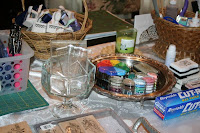
Likewise, with the ink, I set out some of my favorite color stacks, plus the embossing ink, greeting ink, and the stamping inks I use most often. I also set out the embossing powders I use most often as well, along with a tray for the powder and some of the tools I use for embossing.
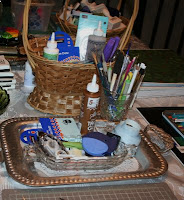
The place where I actually put my card together is recreated from my work table in my studio. I have all of my adhesives, tape runners, Inkessential pens, pencils, ruler, my favorite little detail scissors and tweezers, paintbrushes, Exacto knife, and a mat to work on. In the basket are extra tape refills, glue dots, corner mounts, and adhesive. I don’t want to have to spend precious time on search missions for extra packages of things I’m likely to run out of.
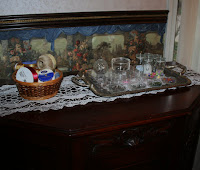
Our china cabinet was the perfect place to put the things I use for finishing touches and embellishments. Again, I chose a selection of ribbons I use most often, plus twine and gold cording since I use those a lot as well. On a tray, I organized brads, eyelets, rhinestones, pearls, beads, and other things, and also set out some of the glitters I use the most. I also have a fishing chest full of buttons and other little accessories that I set down in the corner next to the cabinet. Since my studio is on the lower level of the house, I want to have the things I use the most handy so I can save myself time and energy running back and forth for things.
The last time I set up for a VSN, I think it took me an hour and a half to gather and arrange everything. But that investment of time and effort allowed me to thoroughly enjoy the VSN and to make fully half of the cards without ever leaving this work area. Yes, there will be things you’ll have to get – different stamps, paper, dies and embossing folders – but having the area set up allows you to spend your card-making time very efficiently and for an event like this, where you have time constraints, having things organized and in easy reach helps enormously.
Speaking of “time”, shortly before the VSN starts, I set out a couple of clocks so I can keep track of time and stay on target with the time restrictions. While I have always made a supreme effort to stay within the time limit for the VSN, with the Mini Cabaret, I actually made a note of the amount of time I spent on each card, a habit I’ve carried through with a lot of the cards I now make for the regular challenges. Doing so has helped me to see what kinds of techniques take more or less time and I’ve also become very sensitive to where my time is being “wasted”. I can easily get distracted and a card that takes me “an afternoon” to finish probably only took me an hour, if I take away the time I spent filing paper, talking on the phone, opening the mail, and playing with the dogs. During the last VSN, I got so carried away chatting, there were a couple of challenges where I found myself using much of my “work” time “chatting”. That’s fine – I thoroughly enjoyed the conversations and needed a break from working at that point – but it’s amazing how much time can pass if you aren’t paying attention.
 The inspiration for this card, one of the challenges for last weekend's Crush mini VSN at Splitcoast Stampers, was a vintage chocolate box which you can see and read about here.
The inspiration for this card, one of the challenges for last weekend's Crush mini VSN at Splitcoast Stampers, was a vintage chocolate box which you can see and read about here. I knew that the subtle gold of the ballerina would be lost against the brilliant gold embossing and bright pink and green of my attempt at making a mosaic panel, so I softened the background with a panel of vellum and edged both the vellum and the patterned paper with gold.
I knew that the subtle gold of the ballerina would be lost against the brilliant gold embossing and bright pink and green of my attempt at making a mosaic panel, so I softened the background with a panel of vellum and edged both the vellum and the patterned paper with gold. The floral heart is a plastic trinket that came with a set of vintage buttons and ornaments. It was originally ivory, but I "painted" it with gold ink. Once it was dry, I simply placed it over the knot and pulled the ribbon tails through the center of it.
The floral heart is a plastic trinket that came with a set of vintage buttons and ornaments. It was originally ivory, but I "painted" it with gold ink. Once it was dry, I simply placed it over the knot and pulled the ribbon tails through the center of it.


































